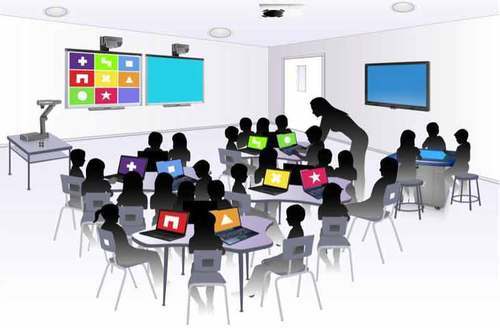The most dominant reason to justify the need for transforming our outdated education system is the absence of advanced technology. Nowadays, when technology is entwined with the youth in a way that its effects on living, working and learning are undeniable, an old-fashioned classroom with whiteboards or blackboards and desks takes students to at least a decade back in time. Future is all about technology and the use of advanced gadgets in education is the most powerful tool to prepare kids to combat the imminent challenges in personal and professional life.
Today’s Pakistani youth, just like others, is a digital native as they have internet everywhere. Predominantly used for entertainment, to connect with friends and for personal empowerment. These digital natives’ unique and advanced knowledge has enabled them to revolutionize the world. In fact, there an innate attribute of being tech-savvy is already transforming the society rapidly. Along with speaking the language of technologies and having creative viewpoints, they are team workers, multitaskers and collaborative. Embraced with gaming and YouTube, children have developed sharp skills and a practical knowledge… Unfortunately, they are yet to utilize all these expertise while learning at a school since most of the institutes have not incorporated technology into education. The policymakers, parents, and members of civil society are reluctant and old-fashioned digital immigrants.
Google and search engines of a similar kind have changed the teaching dynamics completely. Google tends to rank excellent content on the top of their search engine result pages to satisfy each of the user-queries. Due to this, in this era, children now have access to different tech blogs/niche-specific blogs, articles, or youtube to acquire a piece of knowledge. Earlier on, in developed countries, teachers had to work hard on inculcating knowledge in a classroom to shape them into skilled workers. While, today, education’s purpose is brain-empowerment to enable a student to perform individualistic learning, thinking and decision. The teachers in the 21st century are not a source of information since unfathomable information is just a click away now for learners.
With the use of technology, teachers become facilitators in a classroom. Reading from textbooks and writing most of the content on the black or whiteboard and ultimately, making kids copy what they have written on the board isn’t needed.
Lesson plan preparation is a time-consuming effort and often teachers in Pakistan consider it one of the most difficult tasks to perform. Integration of technology and education diminishes the need for lesson planning as a result; it reduces the burden of teachers.
A teacher longs to observe a sincere engagement of a student in his subject but monotonous and dogmatic teaching methodology make learning hard for the students. Conversely, technology provides students’ a variety of solutions in diverse ways keeping their interest intact.
Most of the classrooms in Pakistan comprise of a group with mixed abilities where individually justifying the needs of a learner is only impossible. Hence, oftentimes teachers show dissatisfaction and question the abilities of a slow learner. Contrarily, if they teach too slow or make easy assessments to encourage the slow learning pupils, all the bright learners and school administration questions their performance. With the use of technology, the students can learn according to their ability and pace.
Shouldn’t our kids get rid of the hefty school bags? Bringing books and notebooks is compulsory in almost all of the education institutions until matriculation. The modern world is replacing textbooks with technological resources at a great pace, where laptops, iPads, digital tablets or digital books are increasingly taking place of books and notebooks.
Some of the schools provide the facility of smartboards in classrooms in Pakistan. Due to untrained faculty, most of these are seldom used and serve the purpose of advertisement. Special classrooms are prepared where visitors are invited to observe and praise the availability of technology. While very few schools have trained the teachers and they frequently use these smartboards as they recognize the fact that tech makes teaching lot easier and effective. While in rest of the schools equipped with this facility, interactive boards are used as projector screen only.
The private schools also have projectors installed in certain rooms which are often used for watching movies or showing PowerPoint presentations. These projectors also need proper maintenance and care which is mostly found missing, resultantly, shortens their lifespan.
Commonly, schools either develop a personalized online portal to keep the record of students or buy a readymade software. The major reason for using such portals is keeping track of the number of students and analyzing the performance of branches.
Some of the technological programs creating the difference in education in developed countries include digital books, Google Chromebook and tablets alike that are cost-effective, exchangeable and easy to manage. While DreamBox, ST Math and Zearn are the programs used for Mathematics, for languages programs like Achieve 3000 and No Red Ink are utilized to enhance the reading and writing skills. For assessment, Quizlet’s use is frequent. Precisely, diverse advanced Ed-techs are used in modern classrooms: blogs, social networking, wikis, podcasts, smartphones etc.
Future-oriented education can help prepare kids to cope with what is ahead. Soon all the kids in a classroom will have digital devices. Use of technology enhances the skills of the students making them a competent and updated person. Far better equipped are the technologically assisted individuals notwithstanding whether teachers or students.














